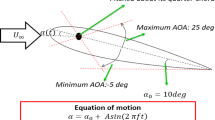Abstract
In order to develop wind resources in low wind speed (LWS) area, a new intelligence algorithm based on the airfoil profile expressed by B-spline for LWS airfoil is proposed. Considering the design requirements for LWS wind turbine airfoil design and taking the DU airfoil as original design coefficients, the new LWS airfoil families with the thickness of 18, 21, 25, 30, 35, 40% were obtained by the particle swarm optimization based on the improved inertia factor and mode. The results show that, compared with the original DU airfoils, all the LWS airfoil families have better aerodynamic performance under free and fixed transition. Performance of the 18% thickness airfoil is improved most significantly: Under fixed transition condition, the maximum lift coefficient increases by 13.53%, and the maximum lift to drag ratio increases by 10.77%; under the free transition condition, the maximum lift coefficient increases by 18.84%, and the maximum lift to drag ratio increases by 11.92%. The aerodynamic performance of a new airfoil named CQUL-180, taken as an example, was analyzed and validated by the computational fluid dynamics compared with DU96-W-180 airfoil, which verifies the reliability of the intelligence algorithm.




















Similar content being viewed by others
References
Yoon, G., Lee, H., Lee, S.H., et al.: Power curve of a wind generator suitable for a low wind speed site to achieve a high capacity factor. J. Electr. Eng. Technol. 9(3), 820–826 (2014)
Preindl, M., Bolognan, S.: Optimization of the generator to rotor ratio of mw wind turbines based on the cost of energy with focus on low wind speeds. In: 2011 Industrial Electronics Conference, pp. 906–911 (2011)
Pourrajabian, A., Ebrahimi, R., Mirzaei, M.: Applying micro scales of horizontal axis wind turbines for operation in low wind speed regions. J. Energy Convers. Manag. 87, 119–127 (2014)
Zhang, J.L., Zhou, Z.G., Lei, Y.S.: Design and research of high-performance low-speed wind turbine blades. In: 2009 World Non-Grid-Connected Wind Power and Energy Conference, pp. 161–165 (2009)
Sangpanich, U., Ault, G.A., et al.: Economic Feasibility of Wind Farm Using Low Wind Speed Turbine. In: Proceedings of the 44th International Universities Power Engineering Conference, pp. 1–5 (2010)
Song, H.H., De, T.: Research on maximum wind energy capturing of DFIG. J. Adv. Mater. Res. 605, 1360–1363 (2013)
Leahy, P.G., McKeogh, E.J.: Persistence of low wind speed conditions and implications for wind power variability. J. Wind Energy 16(4), 575–586 (2013)
Huang, Y.S., Gu, Q.: Design and dynamic analysis of main driving system for 1.5 MW low-speed wind turbine. J. Renew. Energy Resour. 30(1), 21–26 (2012)
Zou, L., Jia, T., Ning, X.Y., et al.: Strength and fatigue analysis of low wind speed turbine hub. J. Renew. Energy Resour. 29(5), 28–31 (2011)
Wright, A.K., Wood, D.H.: The starting and low wind speed behaviour of a small horizontal axis wind turbine. J. Wind Eng. Ind. Aerodyn. 92(14–15), 1265–1279 (2004)
Guo, Z., Chen, X.K.: Development of a solar electric powered UAV for long endurance flight. In: 11th AIAA Aviation Technology, Integration, and Operations (ATIO) Conference, Virginia, AIAA, pp. 2011–6966 (2011)
Pourrajabian, A., Ebrahimi, R., Mirzaei, M.: Applying micro scales of horizontal axis wind turbines for operation in low wind speed regions. J. Energy Convers. Manag. 87(87), 119–127 (2014)
Van Rooij, R.P.J.O.M., Timmer, W.A.: Roughness sensitivity considerations for thick rotor blade airfoils. J. Solar Energy Eng. 125, 68–478 (2003)
Barnes, R.H., Morozov, E.V., Shankar, K.: Improved methodology for design of low wind speed specific wind turbine blades. J. Compos. Struct. 119, 677–684 (2015)
Chen, J., Zhang, S.Q., Hou, Y., et al.: Parametric geometry representations for wind turbine blade shapes. J. High Technol. Lett. 17(3), 325–332 (2011)
Wang, Q., Chen, J., Pang, X.P., et al.: A new direct design method for the medium thickness wind turbine airfoil. J. Fluids Struct. 43, 287–301 (2013)
Srinath, D.N., Mittal, S.: Optimal aerodynamic design of airfoils in unsteady viscous flows. Comput. Methods Appl. Mech. Eng. 199(29–32), 1976–1991 (2010)
Yu, L., Cheng, X.Q., Xiang, J.W.: Multi-objective robust airfoil optimization based on non-uniform rational B-spline(NURBS) representation. J. Sci. China-Technol. Sci. 53(10), 2708–2717 (2010)
Pigel, L., Tiller, W.: The NURBS Book. Springer, Berlin (1997)
Van Dam, C.P., Cooperman, A.: Thick Airfoils With Blunt Trailing Edge for Wind Turbine Blades. J. Proc. ASME TURBO EXPO 5, 923–931 (2010)
Standish, K.J., Van Dam, C.P.: Aerodynamic analysis of blunt trailing edge airfoils. J. Solar Energy Eng. Trans. ASME 125(4), 479–487 (2003)
Shi, Y., Eberhart, R.C.: Fuzzy adaptive particle swarm optimization. In: Proceedings of the Congress on Evolutionary Computation: Seoul, Korea, pp. 101–106 (2001)
Fouad, A.A., Hassanien, A.E., Snasel, V., Tolba, M.F., et al.: A new hybrid particle swarm optimization with variable neighborhood search for solving unconstrained global optimization problems. J. Adv. Intell. Syst. Comput. 303, 151–160 (2014)
ROOIJ, R., Timmer, W.: Roughness sensitivity considerations for thick rotor blade airfoils. J. Solar Energy Eng. Trans. ASME 125(4), 468–478 (2003)
Skrzypinski, W.R., Mac, G., et al.: Self-induced vibrations of a DU96-W-180 airfoil in stall. J. Wind Energy 4, 641–655 (2014)
Acknowledgements
The authors acknowledge the National Natural Science Foundation of China (Grant: 51475056).
Author information
Authors and Affiliations
Corresponding author
Rights and permissions
About this article
Cite this article
Pang, X., Wang, H. & Chen, J. Intelligence algorithm for optimization design of the low wind speed airfoil for wind turbine. Cluster Comput 22 (Suppl 4), 8119–8129 (2019). https://doi.org/10.1007/s10586-017-1635-4
Received:
Revised:
Accepted:
Published:
Issue Date:
DOI: https://doi.org/10.1007/s10586-017-1635-4



